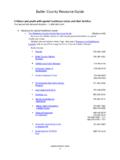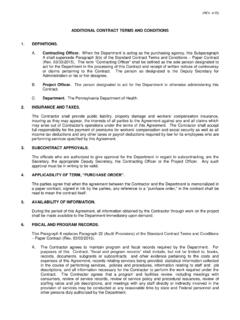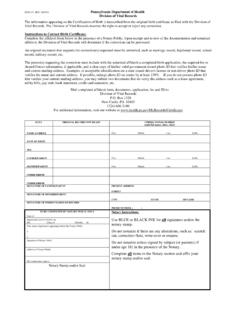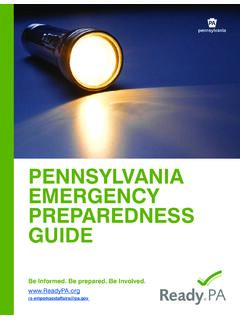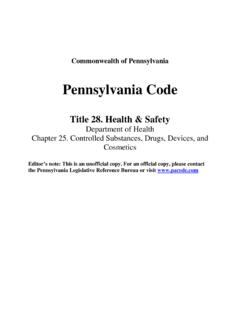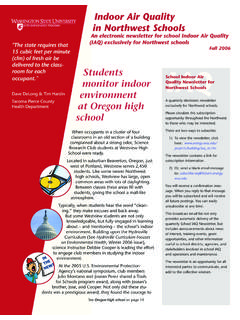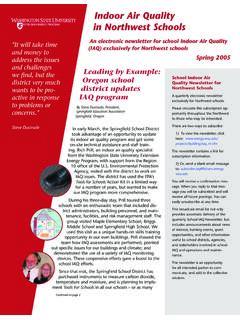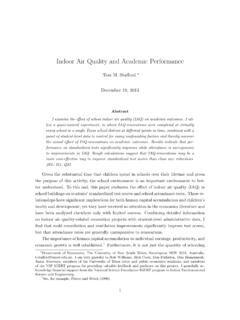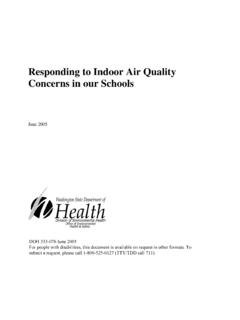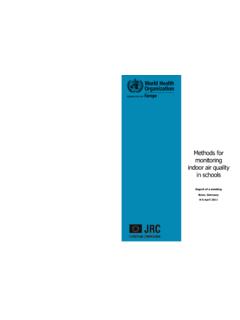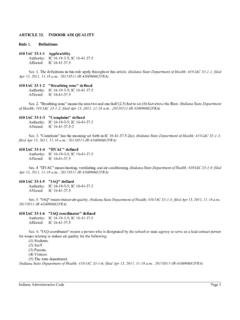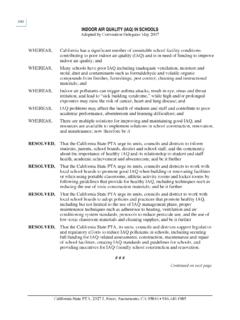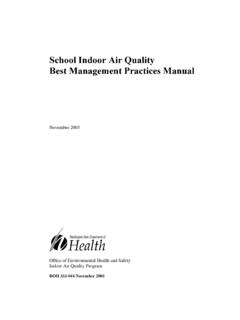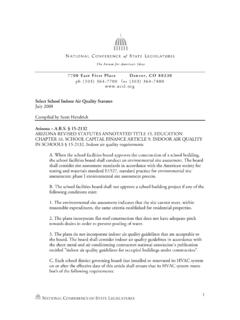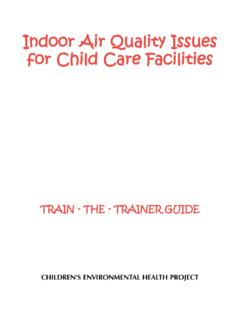Transcription of Indoor Air Quality Guidelines for Pennsylvania Schools
1 Pennsylvania Department of Health Indoor Air Quality Guidelines for Pennsylvania Schools PREFACE This document provides useful information on Indoor air Quality (IAQ) in Schools to school officials and others who have an interest in this topic. It offers practical guidance that will help prevent IAQ problems in Schools , and resolve or alleviate such problems if they do arise. It is particularly designed to assist those officials who have the primary responsibility of providing a safe and healthy environment for students, teachers, and the general school community.
2 This easy-to-use guidance document describes how to implement a practical plan of action using a minimal amount of resources. The document includes general Guidelines to prevent or help resolve IAQ problems, additional Guidelines on specific Indoor contaminants, recommendations on IAQ management approaches, recommendations on seeking professional assistance, and selected resources and references. School Officials are encouraged to review and proactively use the information in this document. Many IAQ problems can be resolved with preventative maintenance approaches as described.
3 Bureau of Epidemiology Indoor AIR Quality Guidelines FOR Pennsylvania Schools This document is designed to provide practical guidance that will help prevent Indoor air Quality (IAQ) problems in Schools and resolve such problems quickly if they do arise. Recommendations for reasonable steps that can be taken by the school staff are offered with an eye toward flexibility for the specific needs of your school. The information in the document has been derived from the Environmental Protection Agency s (EPA s) report, Indoor Air Quality Tools for Schools , other published documents, and our experience in this area.
4 WHY IAQ IS IMPORTANT TO YOUR SCHOOL Most people are aware that outdoor air pollution can damage their health but many do not know that Indoor air pollution can also have significant health effects. EPA studies of human exposure to air pollutants indicate that Indoor levels of pollutants may be 2-5 times, and occasionally 100 times, higher than outdoor levels. These levels of Indoor air pollutants are of particular concern since most people spend the majority of their time indoors. Good Indoor air Quality in Schools is an important component of a healthy Indoor environment.
5 It contributes to a favorable learning environment for students, productivity for teachers and staff, and a sense of comfort, health, and well-being. These elements combine to assist a school in its core mission -- educating children. The definition of good Indoor air Quality management includes control of airborne pollutants, introduction and distribution of adequate outdoor air, and maintenance of acceptable temperature and relative humidity. Temperature and humidity are important because thermal comfort concerns underlie many complaints about "poor air Quality .
6 " Temperature and humidity can also affect Indoor contaminant levels. Failure to respond quickly and effectively to IAQ problems can lead to numerous adverse health, cost, and educational process consequences. Children may be especially susceptible to air pollution The same concentration of pollutants can result in higher body burden in children than adults because children breathe a greater volume of air relative to their body weight. Unlike other buildings, there are many unique aspects of Schools . The occupants of Schools are close together, with the typical school having about four times as many occupants as office buildings for the same amount of floor space.
7 A variety of potential pollutant sources exist in Schools , including art and science materials, industrial and vocational arts, and gymnasiums. In combination with natural ventilation, Schools may use many heating, ventilating, and air conditioning systems (HVAC), including unit ventilators and rooftop units. All require appropriate care and maintenance. TYPICAL IAQ PROBLEMS IN Schools Indoor air contaminants can originate within the school building or be drawn in from the outdoors. If pollutant sources are not controlled, Indoor air problems can develop even if the HVAC system is properly designed, operated, and maintained.
8 Air contaminants consist of particles, dust, fibers, biological agents ( , bacteria, viruses, and mold), and gases or vapors. Sources of Indoor air contamination include polluted outdoor air and underground sources ( , radon, pesticides, and leakage from underground storage tanks). Indoor air contamination can also be caused by a variety of Indoor sources ( , equipment, furnishings, and housekeeping supplies). Indoor concentration levels of air pollutants can vary by time and location within the school building, or possibly a single classroom.
9 Pollutants can be emitted from point sources, such as science storerooms, or from area sources, such as newly painted surfaces. Pollutants can vary with time, such as only when floor stripping is done, or continuously such as fungi growing in the HVAC system. Indoor air often contains a variety of contaminants at concentrations that are well below any standards or Guidelines for occupational exposure. It is often difficult to relate complaints of specific health effects to exposures to specific pollutant concentrations, especially since the exposures may be to low levels of pollutant mixtures.
10 GENERAL Guidelines TO PREVENT OR HELP RESOLVE IAQ PROBLEMS To prevent or help resolve Indoor air Quality problems effectively and efficiently, Schools must ensure that recommended temperature and relative humidity ranges be maintained in the Indoor air and that the HVAC system is working properly. In addition, monitoring for carbon dioxide (CO2) may be useful for indicating when outdoor air ventilation may be inadequate. A properly designed and functioning HVAC system controls temperature and relative humidity levels to provide thermal comfort, distributes adequate amounts of outdoor air to meet the ventilation needs of school occupants, and isolates and removes odors and other contaminants through pressure control, filtration, and exhaust fans.

